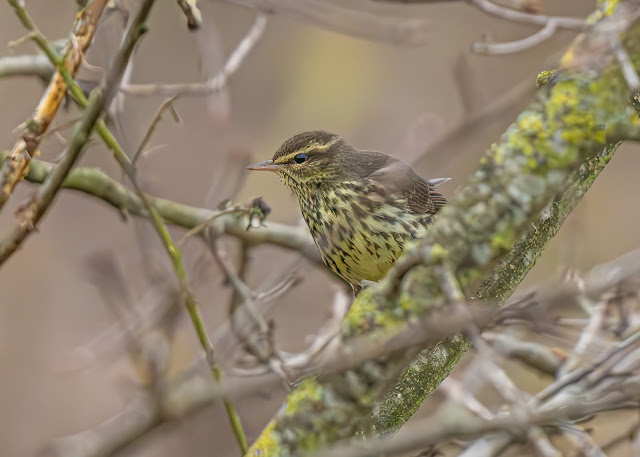I said it before, and I will certainly say it again, its an age thing you know, one of the things I really like about this hobby is the surprises it can throw at you out of nowhere. If you asked me what my first UK tick of the year would be Northern Waterthrush would have come in marginally above the Moa. Fast forward to Wednesday afternoon when a local Essex birder spotted a Moa in his garden …….
Well actually it was a Northern Waterthrush! There was one further tantalisingly brief report of it as it was getting dark. I mentioned it to my ever suffering wife who asked me if I wanted to go. It’s always a bit of a toss-up in such circumstances as to whether to wait for it to be reported again or go very early the next morning. I’ve previously won and lost on both options. Rightly or wrongly I decided to wait on this occasion and was out walking my dogs when the Waterthrush was reported again in a small creek next to the housing estate where it had been found. Given that it was a good three hour drive from home, I had a difficult decision to make. Go immediately knowing that I would have at best 3 hours of good day light to see it or go first thing on Friday. In the end I decided to go straight away and a boring 3 hour motorway drive had me parking in a close by retail park around 12:30. Ten minutes later I was on site overlooking the said stream. I thought it would be packed with birders but, in fact, it was not too bad with perhaps 30 or 40 people present and I soon found a small space in which to set up my scope.
With only seven previous UK records and only two of those being on the mainland, this was a truly mega bird. The Waterthrushes are actually not thrushes at all but new world warblers belonging to the genus Parkesia.There are only two members of the genus, the Northern Waterthrush and the Louisiana Waterthrush which has never been recorded in Europe. The Northern Waterthrush breeds in Canada and the northern states of the USA migrating to Florida, the West Indies, and Central America for the winter. Hence it is almost certain that this bird has been in western Europe since the autumn, possibly arriving with the unprecedented influx of North American passerines in September. It is a relatively large and attractive new world warbler with a strong cream supercilium and a dark pointed bill. The throat is lightly streaked brown to black with heavier streaking continuing onto the breast and flanks. As the name suggests, its preferred breeding habitat is wet woodlands near water. It feeds on insects, snails, worms, and even small fish.
Somewhat worryingly, given there was now perhaps 3 ½ hours of good light left, the bird had not been seen for 2 hours. I passed the time, as is my want, chatting to my fellow birders when I realised that the couple on my left were none other that Banbury birders Karen and Kev. As the time drifted on and the light worsened I started to become quite despondent, surely I was not going to start my birding year with a mega dip? At around 14:00 a commotion to the left of me indicated that the Waterthrush had been spotted. The view was very restricted and I started to panic that I would not see the bird but then it flew into a small tree where it jumped around restlessly for perhaps 2 minutes before diving into thick bramble scrub. It appeared briefly again before flying low over an adjacent house disappearing from view and that was that, it wasn’t seen again that day. On such small brief encounters are days such as this won or lost – funny old hobby.
Luckily, just before the Waterthrush showed in the tree, I took my scope off the tripod and put my camera on allowing me to capture a small number of in focus but partially obscured pictures.
I left in very high spirts that weren’t even damped by a long slog of a drive home through yet more torrential rain.

Comments
Post a Comment